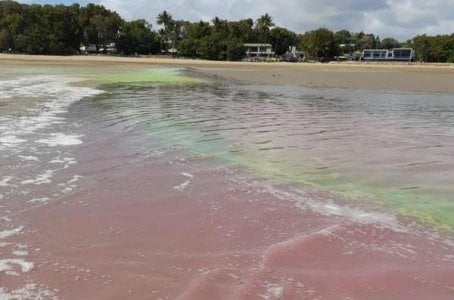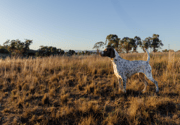Is Australia's Coast Under Threat? The Mystery of the Ominous 'Slick Substance' Revealed!
By
Danielle F.
- Replies 5
Australia's Great Barrier Reef, a natural wonder and a crown jewel in the country's tourism and ecological heritage, is facing yet another potential threat. In recent weeks, a 'slick substance' has been observed off the coast of Mackay in Queensland's north, alarming locals and scientists alike. This phenomenon, characterized by 'thick blankets' of blue-green algae known as sea sawdust, has transformed some beach shorelines into a tapestry of vivid pink and green hues.
The stunning visual spectacle, however, belies a more sinister concern. Residents and beachgoers have reported a distinct and unpleasant odour emanating from the algae. Surfer Dwayne Close described the smell as 'pongy,' a colloquial term for an intense, often unpleasant odour. While the algae itself is not considered harmful to humans and may only cause skin irritation, its presence in such abundance is raising serious ecological alarms.
Blue-green algae, or trichodesmium, is not a stranger to these waters, but its early seasonal bloom has caught the attention of marine scientists. The algae, which typically rises from the ocean floor in calm conditions to form strings and clumps, has been linked to the diet of the crown-of-thorns starfish (COTS) larvae. These starfish are notorious for their destructive appetite for coral tissue, which they can consume at a rate faster than the coral can regenerate.
Dr. Benjamin Mos, a marine scientist, expressed his surprise upon discovering that the larvae of these predatory starfish feast on trichodesmium. This revelation could be a crucial piece in solving the puzzle of the crown-of-thorns starfish's impact on the Great Barrier Reef. The concern is that an abundance of this algae could fuel a surge in the starfish population, exacerbating one of the four main stresses on the reef.
The Great Barrier Reef is already under siege from various angles, including climate change, pollution, and overfishing. The potential for a rise in COTS populations due to an increase in their preferred food source adds another layer of urgency to the ongoing conservation efforts.
Researchers are now keen to observe the larvae consuming the algae in their natural habitat to gain a better understanding of how to control major outbreaks of the starfish. Professor Dworjanyn from Southern Cross University highlighted the importance of this research, suggesting that mitigating the impact of COTS could buy the coral reefs more time to recover and thrive.
Efforts to control the crown-of-thorns starfish populations have been ongoing since 2012, with skilled divers capable of eliminating large numbers of the starfish by manual injection. However, this method has its limitations, and the situation is further complicated by climate change, which can enhance the reproductive capabilities of the starfish.
Evan Quartermain, Head of Programs at Humane Society International, pointed out the daunting reproductive potential of these starfish, with mature individuals capable of releasing up to 200 million eggs annually. In favourable conditions, their populations can explode, leading to devastating consequences for the reef.
The situation off the coast of Mackay serves as a stark reminder of the delicate balance within marine ecosystems and the interconnectedness of life beneath the waves. As Australians and global citizens, we must remain vigilant and supportive of the research and conservation efforts that aim to protect our precious marine environments.

We invite our readers to share their thoughts and experiences regarding the health of the Great Barrier Reef and the challenges it faces. Have you witnessed any changes in your local marine environment? What actions do you think could be taken to safeguard these vital ecosystems for future generations? Join the conversation below and let's discuss the future of Australia's coastal treasures.
The stunning visual spectacle, however, belies a more sinister concern. Residents and beachgoers have reported a distinct and unpleasant odour emanating from the algae. Surfer Dwayne Close described the smell as 'pongy,' a colloquial term for an intense, often unpleasant odour. While the algae itself is not considered harmful to humans and may only cause skin irritation, its presence in such abundance is raising serious ecological alarms.
Blue-green algae, or trichodesmium, is not a stranger to these waters, but its early seasonal bloom has caught the attention of marine scientists. The algae, which typically rises from the ocean floor in calm conditions to form strings and clumps, has been linked to the diet of the crown-of-thorns starfish (COTS) larvae. These starfish are notorious for their destructive appetite for coral tissue, which they can consume at a rate faster than the coral can regenerate.
Dr. Benjamin Mos, a marine scientist, expressed his surprise upon discovering that the larvae of these predatory starfish feast on trichodesmium. This revelation could be a crucial piece in solving the puzzle of the crown-of-thorns starfish's impact on the Great Barrier Reef. The concern is that an abundance of this algae could fuel a surge in the starfish population, exacerbating one of the four main stresses on the reef.
The Great Barrier Reef is already under siege from various angles, including climate change, pollution, and overfishing. The potential for a rise in COTS populations due to an increase in their preferred food source adds another layer of urgency to the ongoing conservation efforts.
Researchers are now keen to observe the larvae consuming the algae in their natural habitat to gain a better understanding of how to control major outbreaks of the starfish. Professor Dworjanyn from Southern Cross University highlighted the importance of this research, suggesting that mitigating the impact of COTS could buy the coral reefs more time to recover and thrive.
Efforts to control the crown-of-thorns starfish populations have been ongoing since 2012, with skilled divers capable of eliminating large numbers of the starfish by manual injection. However, this method has its limitations, and the situation is further complicated by climate change, which can enhance the reproductive capabilities of the starfish.
Evan Quartermain, Head of Programs at Humane Society International, pointed out the daunting reproductive potential of these starfish, with mature individuals capable of releasing up to 200 million eggs annually. In favourable conditions, their populations can explode, leading to devastating consequences for the reef.
The situation off the coast of Mackay serves as a stark reminder of the delicate balance within marine ecosystems and the interconnectedness of life beneath the waves. As Australians and global citizens, we must remain vigilant and supportive of the research and conservation efforts that aim to protect our precious marine environments.
Key Takeaways
- A slick substance identified as blue-green algae has made an appearance at Mackay in Queensland, affecting the local beaches.
- The algae bloom, while not directly harmful to humans, can cause skin irritation and has prompted concerns for the health of the Great Barrier Reef.
- Scientists have discovered the algae may be a food source for the larvae of the crown-of-thorns starfish, a predator that significantly harms coral reefs.
- Researchers are investigating the connection between the algae blooms and starfish outbreaks, aiming to develop strategies to protect the reef from further damage by controlling the population of the crown-of-thorns starfish.
We invite our readers to share their thoughts and experiences regarding the health of the Great Barrier Reef and the challenges it faces. Have you witnessed any changes in your local marine environment? What actions do you think could be taken to safeguard these vital ecosystems for future generations? Join the conversation below and let's discuss the future of Australia's coastal treasures.








